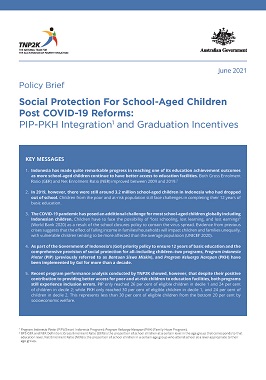Social Protection For School-Aged Children Post COVID-19 Reforms: PIP-PKH Integration and Graduation Incentives
KEY MESSAGES
- Indonesia has made quite remarkable progress in reaching one of its educational achievement outcomes as more school-aged children continue to have better access to education facilities. Both Gross Enrolment Ratio (GER) and Net Enrolment Ratio (NER) improved between 2009 and 2019.
- In 2019, however, there were still around 3.2 million school-aged children in Indonesia who had dropped out of school. Children from the poor and at-risk population still face challenges in completing their 12 years of basic education.
- The COVID-19 pandemic has posed an additional challenge for most school-aged children globally including Indonesian children. Children have to face the possibility of “lost schooling, lost learning and lost earnings” (World Bank 2020) as a result of the school closures policy to contain the virus spread. Evidence from previous crises suggests that the effect of falling income in families/households will impact children and families unequally, with vulnerable children tending to be more affected than the average population (UNICEF 2020).
- As part of the Government of Indonesia’s (GoI) priority policy to ensure 12 years of basic education and the comprehensive provision of social protection for all–including children–two programs, Program Indonesia Pintar (PIP) (previously referred to as Bantuan Siswa Miskin), and Program Keluarga Harapan (PKH) have been implemented by GoI for more than a decade.
- Recent program performance analysis conducted by TNP2K showed, however, that despite their positive contribution to providing better access for poor and at-risk children to education facilities, both programs still experience inclusion errors. PIP only reached 26 percent of eligible children in decile 1 and 24 percent of children in decile 2; while PKH only reached 30 percent of eligible children in decile 1, and 24 percent of children in decile 2. This represents less than 30 percent of eligible children from the bottom 20 percent by socioeconomic welfare.
